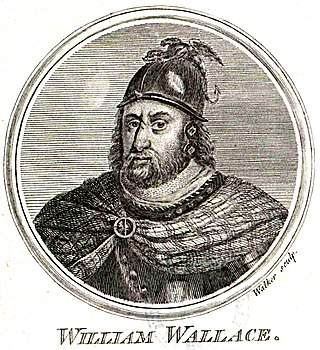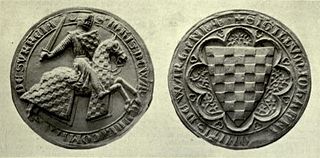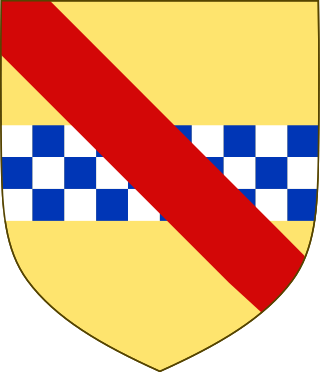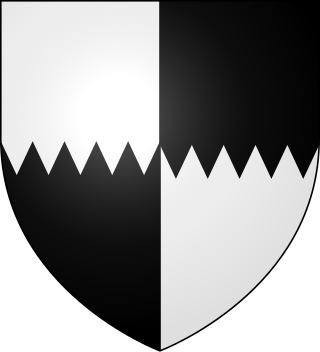
Sir William Wallace was a Scottish knight who became one of the main leaders during the First War of Scottish Independence.

Year 1297 (MCCXCVII) was a common year starting on Tuesday of the Julian calendar.

The Wars of Scottish Independence were a series of military campaigns fought between the Kingdom of Scotland and the Kingdom of England in the late 13th and early 14th centuries.

The Battle of Stirling Bridge was a battle of the First War of Scottish Independence. On 11 September 1297, the forces of Andrew Moray and William Wallace defeated the combined English forces of John de Warenne, 6th Earl of Surrey, and Hugh de Cressingham near Stirling, on the River Forth.

The Battle of Falkirk, on 22 July 1298, was one of the major battles in the First War of Scottish Independence. Led by King Edward I of England, the English army defeated the Scots, led by William Wallace. Shortly after the battle Wallace resigned as Guardian of Scotland.
Andrew Moray, also known as Andrew de Moray, Andrew of Moray, or Andrew Murray, was an esquire, who became one of Scotland's war-leaders during the First Scottish War of Independence. Moray, heir to an influential north Scotland baron, initially raised a small band of supporters at Avoch Castle in early summer 1297 to fight King Edward I of England, and soon had successfully regained control of the north for the absent Scots king, John Balliol. He subsequently merged his army with that of William Wallace, and jointly led the combined army to victory at the Battle of Stirling Bridge on 11 September 1297. Moray was mortally wounded in the fighting at Stirling, dying at an unknown date and place that year.

John de Warenne, 6th Earl of Surrey was a prominent English nobleman and military commander during the reigns of Henry III of England and Edward I of England. During the Second Barons' War he switched sides twice, ending up in support of the king, for whose capture he was present at Lewes in 1264. Warenne was later appointed a Guardian of Scotland and featured prominently in Edward I's wars in Scotland.

The First War of Scottish Independence was the first of a series of wars between English and Scottish forces. It lasted from the English invasion of Scotland in 1296 until the de jure restoration of Scottish independence with the Treaty of Edinburgh–Northampton in 1328. De facto independence was established in 1314 at the Battle of Bannockburn. The wars were caused by the attempts of the English kings to establish their authority over Scotland while Scots fought to keep English rule and authority out of Scotland.
Gartnait of Mar, Earl of Mar – Gartnait mac Domhnall, 8th Mormaer of Mar, was a Scottish noble during the first War of Scottish Independence (1296–1328). His name is sometimes rendered as Gartney or Gratney. A son of Domhnall I, Earl of Mar, and his wife, Elen ferch Llywelyn, Gartnait of Mar died in about 1305.

John Comyn, 3rd Earl of Buchan was a chief opponent of Robert the Bruce in the civil war that paralleled the War of Scottish Independence. He should not be confused with the better known John III Comyn, Lord of Badenoch, who was his cousin, and who was killed by Bruce in Dumfries in March 1306. Confusion between the two men has affected the study of this period of history.

Sir William Douglas "le Hardi", Lord of Douglas was a Scottish nobleman and soldier.

The Wallace Sword is an antique two-handed sword purported to have belonged to William Wallace (1270–1305), a Scottish knight who led a resistance to the English occupation of Scotland during the Wars of Scottish Independence. It is said to have been used by William Wallace at the Battle of Stirling Bridge in 1297 and the Battle of Falkirk (1298).
Events from the 1290s in England.

Henry de Percy, 1st Baron Percy of Alnwick was a medieval English magnate.
The Capitulation of Irvine was an early armed conflict of the Wars of Scottish Independence which took place on 7 June 1297. Due to dissension among the Scottish leadership, it resulted in a stand-off.

Sir John Stewart, the brother of Sir James the 5th High Steward of Scotland, was a Scottish knight and military commander during the First Scottish War of Independence.

Sir William FitzWarin was an English soldier active during the First War of Scottish Independence. He was the constable of Urquhart Castle (1296-1297) and after the English defeat at the Battle of Stirling Bridge on 11 September 1297, he was appointed constable of Stirling Castle, which he later surrendered and was imprisoned in Dumbarton Castle.
The English invasion of Scotland of 1298 was a military campaign undertaken by Edward I of England in retaliation to a Scottish uprising in 1297, the defeat of an English army at the Battle of Stirling Bridge and Scottish raids into Northern England.

William de Ormesby was a 13th-14th century English judge. He was the Justice of Scotland between 1296 and 1297 after the invasion of Scotland by England in 1296.
The English invasion of Scotland of 1296 was a military campaign undertaken by Edward I of England in retaliation to the Scottish treaty with France and the renouncing of fealty of John, King of Scotland and Scottish raids into Northern England.














